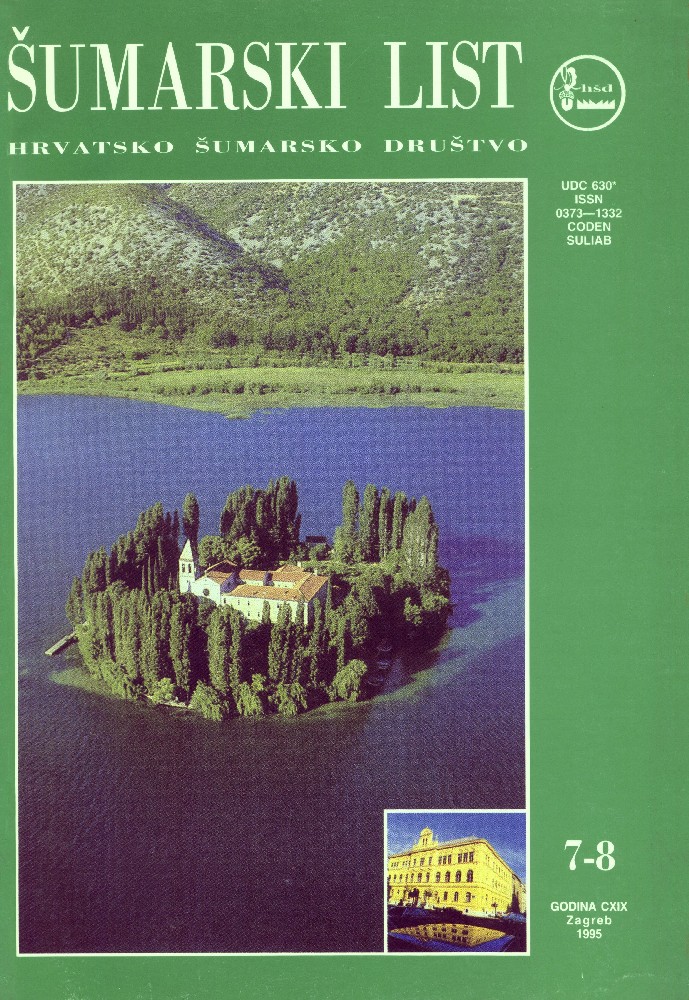
broj: 7-8/1995
pdf (13,8 MB) |
|
||||||||||||||
| B. Prpić | ||
| XX. WORLD CONGRESS IUFRO PDF HR | 221 | |
| IZVORNI ZNANSTVENI ČLANCI | ||
| Trinajstić, I. | UDK 581.9 (Quercus ilex L.) (497.13) | |
| Sintaxonomical Investigations of Holm Oak, (Quercus ilex L.) Forests in East Istria, Croatia pdf HR EN | 223 | |
| Ante TOMAŠEVIĆ | UDK 630*232.322.9 (Pinus sp.) | |
| Višegodišnji rezultati istraživanja uspjeha pošumljavanja na kršu alepskim borom (Pinus halepensis Mill.), crnim borom (Pinus nigra Arn.) i primorskim borom (Pinus pinaster Ait.) kod tri različite metode pripreme tla za pošumljavanje. pdf HR EN | 227 | |
| Summary: Afforestation of the Karst in Croatia started as for back as the last century. May 7th, 1878, is considered to be the beginning of the organized word on afforestation of the Karst in Croatia when the »Inspectorate for Afforestation of the Karst« was funded in Senj. Thus, Croatia has a long tradition of 117 years in the afforesation of the Karstrocky ground. After this conturylong period, Croatia is still far from having the Karst area afforested, and nowdays we can say that Croatia is still at the start of the battle with the Karst wasteland. Multiple reasons, explaining this situation, exist. During ist long history Croatia predominantly was under foreign administration, and although favourable Acts on afforestation of the Karst rocky ground were passed, the application of the Acts in practice was met with difficulties. Apart from the aformentioned, during some twenty years in the recent past, forest fires have unmercifully devestated the forest vegetation and newly-planted pine plantations. A particular emphasis should be placed on the fact that since 1990, the year of Serbo-Chetniks aggression on Croatia, the objects of their intentional destruction were also the forests and forest plantations, thus, makong the present state of the forester the Karst much worse than it had been prior to the Serbo-Chetnik´s aggression. Wider regions of Dubrovnik, Šibenik and Zadar have suffered particularly heavy damage. Unfortunately, it has to be said that the results of the afforestation activities on the Karst are very small. On the other hand, if we analyse the forestry profession and the archieved degree of afforestation techniques it can be said that the most up-to-date work methods were applied in practice, and that a remakable success in the plant survial was achived, reaching over 90 m, if not to say 100, at times. Three methods of soil preparation for afforestation were applied by the author: — Afforestation by planting and pickaxe, cat in plating — Afforestation by planting into holes by STIHL 08 — Afforestation by planting on soil undermined by ripper. On the soil undermined by the ripper the following species were planted: Aleppo Pine (Pinus halepensis Mill.), Austrian Pine (Pinus nigra Arn.) and Maritime Pine (Pinus pinaster Ait.). On the terrains of the Forest Districts of Zadar and Šibenik the one-year plants of Aleppo Pine were planted, and in the area of the Forest District of Split the one-year plants of Austrian Pine and Martime Pine, were planted. The Aleppo Pine seedlings in the area of the Forest District of Zadar were cultivated in polyethylene pipes, 6 cm. in diameter and 28 cm. in height. Seedlings for the area of the Forest District of Šibenik and the Forest District of Split were cultivated in the »Bosnaplast« container, 12 cm in depth. In all the experimental plots the heights of plants were measured at the end of vegetational period in centimeters, and the mortality of the planted seedlings was registered at the same time. The results of the research are presented in the GRAPHS 1-16. The best survival results of the planted seedlings for all three species were displayed by the method of soil undermined by the reppier. In the area of the Forest District of Split and its sub-Mediterranean part, at approximately 600 m above sea level, comparison of results was carried out for all three methods of soil preparation for the afforestation with the Austrian Pine and the Maritime Pine, and these results are shown in the GRAPHS 5-16. Šumarski list br. 7—8, CXIX (1995), 227—236 | ||
| Sinković, T. | UDK 630*812 (Abies alba Mill.) | |
| Some Physical Properties of Juvenile and Mature Fir-Wood (Abies alba Mill.) from Zalesina pdf HR EN | 237 | |
| PRETHODNO PRIOPĆENJE | ||
| Diminić, D., Glavaš, M., Hrašovec, B. | UDK 630*449+453 (Pinus nigra) | |
| Mycoses and Insect Pests in Austrian Pine Plantations of Crikvenica — Vinodol Area pdf HR EN | 245 | |
| PREGLEDNI ČLANCI | ||
| Figurić, M. | UDK 630*903+829(497.13) | |
| Forestry and Wood Processing - Options for Sustainable Development pdf HR EN | 253 | |
| STRUČNI ČLANCI | ||
| Tolić, I. | UDK 630*232.32 | |
| Production of Forest Planting Material in Karst Conditions pdf HR EN | 261 | |


